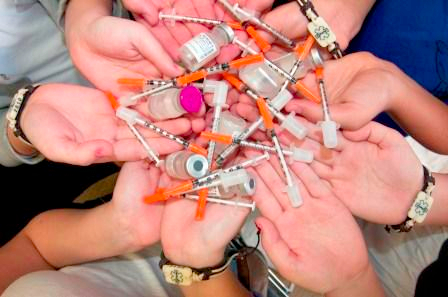
Figures from the International Diabetes Federation (IDF) suggest that 371 million people are currently living with diabetes worldwide, up from 366 million a year ago. The UAE has one of the highest rates of diabetes in the world. It currently affects 18.9 per cent of the population, according to Diabetesuae.ae. Handled prudently, type 2 diabetes is manageable. Experts say a healthy diet, regular exercise regime and medication can help control the disease.
Type 2 diabetes patients register high blood sugar levels. It is either because the body fails to produce enough insulin to maintain a normal blood glucose level, which is called insulin deficiency, or cells simply don’t respond to the hormone.
While type 1 diabetes is an autoimmune disorder, type 2 is largely the result of excess body weight and physical inactivity, affecting 90 per cent of diabetics around the world. Type 2 diabetes mostly occurs in adulthood, usually after the age of 40; however, nowadays even children as young as five are showing symptoms.
GN Focus asks a panel of doctors to look into some of the issues associated with diabetes. The panel includes Dr Sekhar Sankar Wariar, Specialist Cardiologist, Aster Medical Centre, Dr Samer Mohamed Kaaka, Specialist Cardiologist, Medcare Hospital, Dr Roula Amer, Dermatologist, American Hospital Dubai, Dr Omar Kamel Hallak, Chief Interventional Cardiologist, American Hospital Dubai, Dr Deepa Nambiar, GP Dentist, iCare Clinics and Dr Rajendran R. Nayar, General Practitioner, iCare Clinics.
Cardiovascular disease
Condition: Cardiovascular disease refers to problems created by plaque build up in the walls of the arteries. This increases the risk of heart attacks and strokes.
Diabetic connection: Patients with type 2 diabetes do not have enough insulin to move the sugar into the cells. This results in high levels of glucose in the blood. “Excessive blood sugar can damage blood vessel walls. The damage makes it easier for fatty deposits or plaque to form on the inside walls. If there is blockage, the blood cannot flow to the heart resulting in a heart attack,” explains Dr Kaaka. Furthermore, people with type 2 diabetes often suffer from high blood pressure, abnormal cholesterol, high triglycerides and obesity, which contribute to the risk of cardiovascular disease.
Management: “Control blood glucose to reduce the risk of a cardiovascular disease by 42 per cent and the risk of heart attack, stroke or death from a cardiovascular disease by 57 per cent,” says Dr Wariar. “Losing weight by dietary discretion and regular physical activity helps improve one’s diabetes status. Quit smoking to further reduce risks.”
Skin and foot problems
Condition: Diabetes may cause multiple skin and foot problems such as excessive dryness, itchiness, skin discolouration, scaling, calluses, broken skin between the toes, athlete’s foot, bunions and other foot deformities.
Diabetic connection: Diabetic neuropathy or nerve damage is the leading cause of foot problems and ulcers. American Diabetes Association explains that excess blood glucose can injure the walls of tiny blood vessels, especially in the legs, and that’s why it is critical for diabetics to control blood sugar levels to reduce the nerve damage and prevent complications.
Management: Diabetic patients should be screened at least once a year to identify risks for foot ulceration, points out Dr Amer. She recommends that patients with existing nerve damage avoid smoking as it can worsen heart and vascular problems and reduce blood circulation. “Avoid activities that can injure the feet such as walking barefoot, the use of heating pads or hot water bottles and stepping into a bath without checking the temperature. Always trim your toenails and file them to remove sharp edges,” she says.
Oral health issues
Condition: People with diabetes are at a significantly higher risk of developing oral health problems than non-diabetics.
Diabetic connection: Serious gum disease and other dental complications are common among those with diabetes because of their lower resistance to infection and slower healing process. Salivary gland hypofunction leading to reduced production of saliva also adds up to the oral problems in diabetics, points out Dr Nambiar. High blood sugar level can also increase the susceptibility to oral opportunistic infections such as oral candidiasis, which can appear as white and red patches and cause difficulty in swallowing. “Diabetes can also lead to dry mouth, which, in turn, can lead to tooth decay, soreness, ulcers and bad breath,” Dr Nambiar adds.
Management: Develop good oral hygiene to avoid toothaches and other dental issues. “It is important for diabetics to go for regular dental check-up and periodontal screening every six months. Also follow a well-balanced diet plan to keep your sugar levels in control,” advises Dr Nambiar.
Hypertension
Condition: High blood pressure or hypertension is a condition where the blood pressure in arteries rises. If not monitored it can lead to heart diseases and renal failure. Doctors believe that poor eating habits are to be blamed for the hypertension condition.
Diabetic connection: Hypertension is an extremely common condition in diabetics. It affects between 20 and 60 per cent of all diabetic patients depending on obesity, ethnicity and age, says American
Diabetes Association. “There’s a strong association between diabetes and hypertension. There are many patients who have diabetes and hypertension at the same time,” points out Dr Hallak.
Management: “Though blood pressure readings vary most people with diabetes should have a reading of not more than 140/80, says Dr Nayar. “When it comes to preventing complications, normal blood pressure is as important as good control of blood sugar levels,” says Dr Nayar. Weight reduction and a healthy diet can substantially help control high blood pressure.










